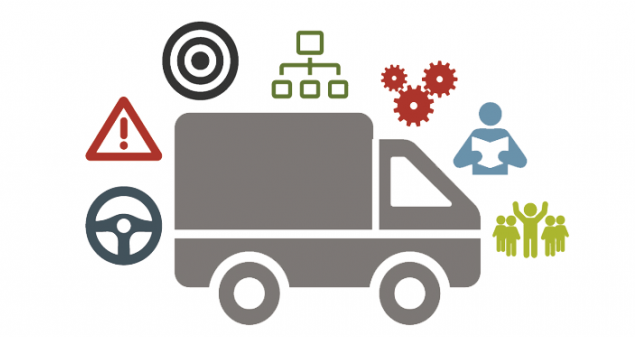

What solutions can help us realize Vision Zero when working with goods vehicles? In the context of the A+A Congress of 25–29 October 2021, the ISSA Section on Prevention in Transportation has built a bridge between everyday practical challenges and the ideals of Vision Zero with a symposium on this question.
Vision Zero stands for a world without occupational accidents and work-related diseases and, in particular, the prevention of fatal and serious occupational accidents and diseases. As noted during the symposium: In one of the most accident-prone sectors of the economy, such as road haulage, there is still much that can be done to move closer to the Vision Zero mission statement.

A series of real-world examples presented approaches to familiar problems, such as falling off the vehicle, and showed how new solutions are helping drivers reduce risks when turning and reversing. In line with the holistic approach of Vision Zero, the focus was not only on the driving activity itself, but also on aspects such as the design of work processes, the procurement of commercially used vehicles and a culture of prevention.
In eight technical lectures, eleven speakers from at home and abroad presented the main challenges and realistic solutions for safe and healthy work in the road haulage sector. You can download the presentations here and you can find the program here.
In the first presentation The safety of goods vehicles in the EU, Jenny Carson of our Section member ETSC (European Transport Safety Council, Belgium) introduced the PIN Flash Report 39 of her organization. Every year, thousands of people die during truck crashes in the EU. Many of them are drivers of trucks, but even more are car passengers and vulnerable road users. In the countries from which the data are obtained, trucks represent a greater risk for other participants in traffic than other vehicles. And that has to change! The solutions for preventing many traffic fatalities in relation to trucks have been at our disposal for years. Ms Carson closed her presentation with numerous concrete ETSC recommendations for the EU member states, the EU and for companies.
As the second lecturer, Section member Dr Arto Reiman of the University of Oulu (Finland) offered an interesting look at data he studied on industrial accidents with, and above all on, road haulage vehicles. This was titled Occupational safety in road transportation. Answering the question, What can we learn from the accident statistics? he explained to his listeners that the challenges must be addressed from the perspective of a broad spectrum of actors. Specifically in terms of the fact that a great number of industrial accidents happen on trucks, it will take more than only the drivers or the transport company to contribute to solving the problems regarding safety and health protection during work with road haulage vehicles. For example, all safety managers at loading and unloading stations and rest stops, as well as customers, truck manufacturers and infrastructure planners must step up and do their part.
In the presentation No safety without health, Dr Karin Müller and her co-author Susanne Kreißig (both: DEKRA e.V./ DEKRA Automobil GmbH, Germany) presented the Development of a health promotion program for professional drivers from DEKRA.
In addition to technology and infrastructure, vehicle drivers and their physical and mental condition are crucial for ensuring the safety of freight transport on the road. The presentation placed a particular focus on health as one of the key factors for safe traffic participation of professional truck drivers.
The truck driver's workplace has numerous physical and psychological risk factors. Studies show that drivers suffer from a number of adverse health effects due to a lack of exercise, work-related stress and unhealthy nutrition, among other factors (Michaelis 2008).

The aim of the project started by DEKRA in 2019 is to develop company and inter-company intervention measures for health prevention among this occupational group and to aim for a lifestyle-related change in behavior. In a mobile program for the health promotion of professional drivers, the requirements of the road transport workplace are to be taken into account and both working conditions and individual behavior as well as their interactions are to be included.
There are also countries where questions of safety and health during work in road haulage have an entirely different dimension. In his presentation on Safe driving practices, Hon Hakeem Dickson of Section member Total Workplace Safety Management Systems Ltd, Nigeria, demonstrated the Nigerian perspective. His powerful images highlighted the fact that in Nigeria there are still many structural problems regarding the design of highways, the enforcement of traffic and industrial safety laws and the collective consciousness that hinder safe participation in road traffic for all participants. For professional truck drivers who earn their living on Nigerian roads, work literally means, risking their lives, day in and day out. This situation can be improved by providing suitable technical equipment, modernizing traffic management, education, and improving law enforcement.
One thing that contributes to increased risk of accidents not only in Nigeria but all over the world is distraction on the road. With the increasing use of mobile telephones at the wheel and the increasing complexity of vehicle control systems, drivers are being distracted and accidents are occurring with alarming frequency.
On the subject of distraction, Section member BG Verkehr has developed media that inspires discussion and provides information about distraction in road traffic. Hans Hessner (BG Verkehr, Germany) presented these and other media in his presentation Driving: risks and solutions. In addition to media on the subject of distraction, he also presented Mirror Setting Plans and the Purchasing Guide. The former is a tool to help drivers set their mirrors. These are placed beside and in front of the vehicle to ensure an optimal panoramic view through the visual fields of the mirrors. Well-adjusted mirrors can help prevent accidents with trucks, particularly during right turns. The Purchasing Guide for the purchase of new commercial trucks and trailers provides valuable decision-making aids. The focus is on occupational safety and health.
In the sixth presentation, Antje Ermer and Philipp Steimer of our Section member ISSA Chemistry Section /BG RCI, Germany presented Practical tools for knowledge transfer in the dangerous goods transportation sector.
Particularly when it comes to subjects such as legal specifications that tend to come across as ‘boring’, there is a need for colorful material for instruction and educational use. The video ‘Dangerous goods and hazardous substances: transport safely - work safely’, published by the ISSA Chemistry Section and BASF SE, provides basic knowledge about what needs to be observed to ensure that chemicals can be transported safely from production to use. It shows when the regulations for the safe handling of hazardous substances apply and when those for the transport of dangerous goods apply. The video can be used during training courses or instruction sessions. It is available in three languages: German, English and French.
The BG RCI learning module "Dangerous Goods Interactive" visualizes exemplary different scenarios of the transport of dangerous goods in the form of freely viewable 3D models, which also contain various deviations from the legal regulations. Using the task and solution sheets linked for free download, users can test their own dangerous goods knowledge in a practical way or use the module in learning and practice seminars to impart knowledge. This tool is available in German, but its content is applicable to all countries due to the ADR dangerous goods regulations. The software is available to anyone.
Next, Jörg Bergmann of the Berufsgenossenschaft Nahrungsmittel und Gastgewerbe (BGN), Germany, gave a presentation titled BGN Intralog. A web application for risk management in intralogistics, which supports risk assessment and the choice of suitable protective measures.
The web application offers an overview of risk-reducing measures for each of four central problem areas in internal transport and traffic. These measures vary in complexity and also in effectiveness, as indicated in the app by a point value associated with the measure. Through their choice of measures, users of the app collect at least enough points to keep the remaining risk as low as possible. Depending on the company's circumstances, either a larger number of simple and usually less expensive measures or a few more complex measures can be combined. The app offers both technical and organizational measures as well as personnel-related measures. For many measures, there are also practical aids that are regularly reviewed and updated. The web application is free of charge and available to anyone. There will always be residual risks in intralogistics, but with the web app "BGN Intralog", these can be identified and reduced almost effortlessly.
Finally, Martin Küppers and Bernd Hörter of BG Verkehr, Germany, demonstrated, in their contribution More than driving. Commercial vehicles as work equipment, how trucks and trailers have some special features as work equipment and what this means for occupational safety.
Commercial vehicles are used as work equipment in almost every company. The versatile use and technical design of commercial vehicles means that they are much more than just means of transport. This is also reflected in the number of accidents. Statistics from BG Verkehr show that although traffic accidents make up only a relatively small proportion of reportable occupational accidents in freight transport, the consequences of injuries are particularly severe.
The majority of accidents occur during activities on and around vehicles. The main focus is on falling or crashing from vehicles, accidents during loading activities, e.g. as a result of being hit by the load and hazards in internal traffic, as well as accidents with vehicles rolling away, e.g. when connecting and disconnecting. In addition to the wide range of activities involving commercial vehicles, the presentation also included reports on accidents at work with commercial vehicles and current trends in the design of regulations.
The symposium was concluded with intensive discussions and a fruitful exchange of possible solutions. The event took place at the CCD in Düsseldorf as part of the A+A Congress program 2021.
The 37th International A+A Congress took place from 27–29 October 2021 in Düsseldorf. For the first time, many speakers and participants were present online. In total, around 1,500 participants from Germany and abroad exchanged ideas on site and online. Classic areas such as exposure to carcinogenic hazardous substances or musculoskeletal disorders caused by work were important. Many participants also wanted to know more about the design of workplaces. The audience was also focused on topics such as safe and healthy working in international supply chains, forms of digitalization in the workplace, such as support from exoskeletons, new work and mobile working. The congress was supported by a poster exhibition.
FURTHER READING
VIEW ALL NEWS






